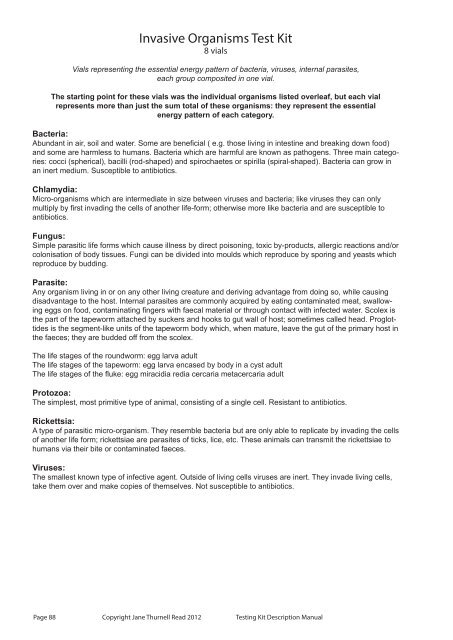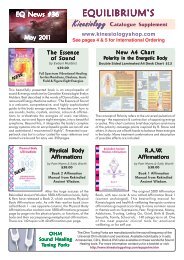You also want an ePaper? Increase the reach of your titles
YUMPU automatically turns print PDFs into web optimized ePapers that Google loves.
Invasive Organisms Test Kit<br />
8 vials<br />
Vials representing the essential energy pattern of bacteria, viruses, internal parasites,<br />
each group composited in one vial.<br />
The starting point for these vials was the individual organisms listed overleaf, but each vial<br />
represents more than just the sum total of these organisms: they represent the essential<br />
energy pattern of each category.<br />
Bacteria:<br />
Abundant in air, soil and water. Some are beneficial ( e.g. those living in intestine and breaking down food)<br />
and some are harmless to humans. Bacteria which are harmful are known as pathogens. Three main categories:<br />
cocci (spherical), bacilli (rod-shaped) and spirochaetes or spirilla (spiral-shaped). Bacteria can grow in<br />
an inert medium. Susceptible to antibiotics.<br />
Chlamydia:<br />
Micro-organisms which are intermediate in size between viruses and bacteria; like viruses they can only<br />
multiply by first invading the cells of another life-form; otherwise more like bacteria and are susceptible to<br />
antibiotics.<br />
Fungus:<br />
Simple parasitic life forms which cause illness by direct poisoning, toxic by-products, allergic reactions and/or<br />
colonisation of body tissues. Fungi can be divided into moulds which reproduce by sporing and yeasts which<br />
reproduce by budding.<br />
Parasite:<br />
Any organism living in or on any other living creature and deriving advantage from doing so, while causing<br />
disadvantage to the host. Internal parasites are commonly acquired by eating contaminated meat, swallowing<br />
eggs on food, contaminating fingers with faecal material or through contact with infected water. Scolex is<br />
the part of the tapeworm attached by suckers and hooks to gut wall of host; sometimes called head. Proglottides<br />
is the segment-like units of the tapeworm body which, when mature, leave the gut of the primary host in<br />
the faeces; they are budded off from the scolex.<br />
The life stages of the roundworm: egg larva adult<br />
The life stages of the tapeworm: egg larva encased by body in a cyst adult<br />
The life stages of the fluke: egg miracidia redia cercaria metacercaria adult<br />
Protozoa:<br />
The simplest, most primitive type of animal, consisting of a single cell. Resistant to antibiotics.<br />
Rickettsia:<br />
A type of parasitic micro-organism. They resemble bacteria but are only able to replicate by invading the cells<br />
of another life form; rickettsiae are parasites of ticks, lice, etc. These animals can transmit the rickettsiae to<br />
humans via their bite or contaminated faeces.<br />
Viruses:<br />
The smallest known type of infective agent. Outside of living cells viruses are inert. They invade living cells,<br />
take them over and make copies of themselves. Not susceptible to antibiotics.<br />
Page 88 Copyright Jane Thurnell Read 2012 Testing Kit Description Manual



